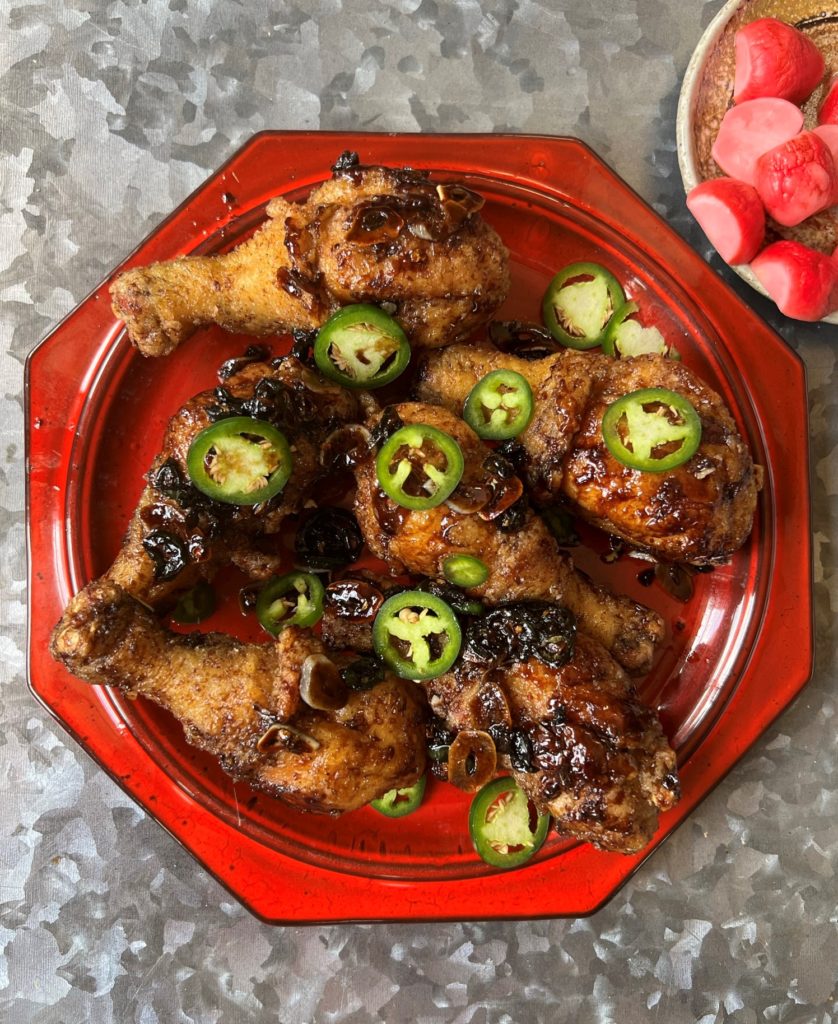
Every once in a while, I come across a cookbook that’s a pleasure to read, cook, and learn from. Such is the case with Eric Kim’s Korean American, a wonderful work that bridges generations with verve, candor and humor.
I’ve kept up with Kim’s work since he was at Food 52 and years ago, he edited my work. Now, he is a staff columnist for the New York Times where his work isn’t solely about Korean food (he developed an artichoke pizza lasagna recipe and chamomile tea cake, for example), but it’s always soulful. He knows how to cook and write. He’s clever in combining ingredients without over complicating things. He understands the home cook.
For all those reasons, Korean American is a very accessible cookbook. Kim doesn’t get fancy with salt, for example. He prefers Morton’s kosher salt over Diamond Crystal, which many chefs like but is not always available to home cooks. He also says Kikkoman soy sauce is fine.
Unfussy, Head-Turner Recipes
Kim’s book is full of intriguing recipes to make. He admits that bibimbap, one of the most popular Korean dishes, is a time sucker for home cooks (that’s real writing!). His sheet-pan solution is a smart, streamlined approach to making the dish (second photo below) doable for everyone.

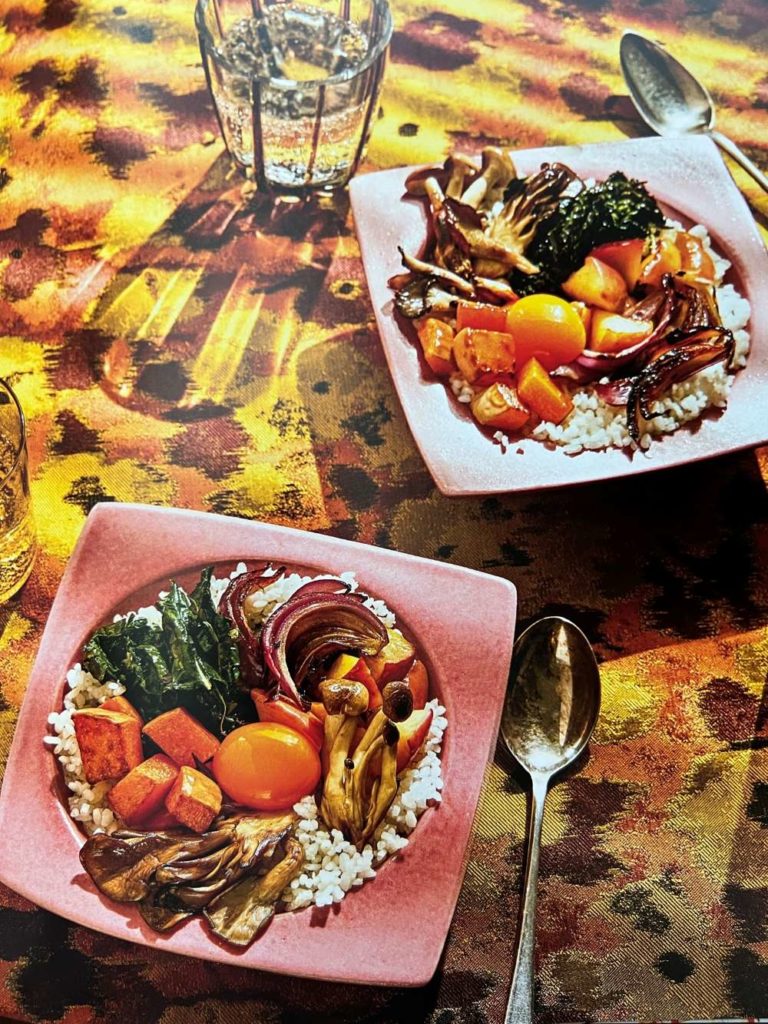
Sunday-Night Chicken Sujebi merges Kim’s approach to slowly simmered chicken soup with his mom’s chewy best sujebi hand-torn doughy dumpling. The broth is typically made from dried anchovies but Kim goes for more punch by simmering the soup with a whole chicken, lots of garlic and bay leaves. There’s a Little Gem Salad with Korean seaweed snacks that’s dressed with rice vinegar, fish sauce and sesame oil – like a vibrant Caesar. Honeyed Biscuits is Kim’s recreation of a buttery, somewhat caramelized KFC biscuit that he ate in Korea and his father says he ate in America.
Southern and Fine-Tuned
Each person’s life experience contributes to the special seasoning in the food they prepare. Kim grew up in Georgia so there’s a southern lilt and charm in his recipes: Ganjang Gejang raw crab marinated in soy sauce is prepared with North Carolina critters. Sounds unusual but he charmingly coaxes you with the promise that the flesh is cured and luscious, with “a softer set than ceviche.” He then explains how the dish is a “rice thief” because you eat rice between bites to relieve and balance the intense deliciousness. You may never make or eat such fresh ganjang gejang, but you may feel like you have from Kim’s prose. You’ll likely want to and will make his Gochugaru Shrimp and Grits.

Kim and his mother, Jean, perfected her kimchi recipe for the book; they even include her Korean mom tips and a beet-stained variation. There are many kimchi recipes out there but this one not only combines some interesting ingredients but it also embodies the importance of transmitting cooking knowledge within families – something we can all identify with.
Double-Double Crunchy Fried Chicken
I wanted to fry chicken but not have to brine like I’ve done before. Kim’s recipe for Aunt Georgia’s Soy Sauce Fried Chicken with Jalapenos fit the bill. It’s not the usual Korean fried chicken coated in chile sauce, which I’ve made with tips from a Korean friend (here) and from Maangchi's cookbook as chicken nuggets (here). Aunt Georgia’s fry chicken is unbelievably simple and loaded with crunch. Her approach is two-fold: coat the chicken twice in lots of potato starch and frying twice. The coating is left to become damp so as to create a sticky batter of sorts.
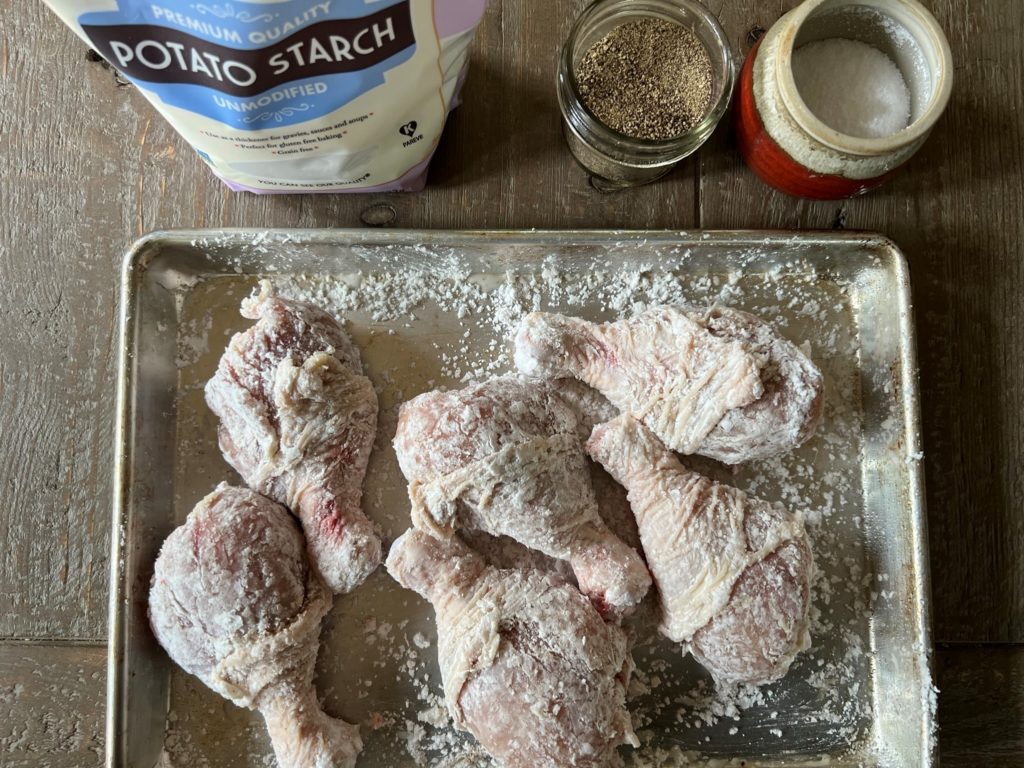
The double frying is fascinating because there’s no long rest between frying. You just take the chicken out and replace it the oil. The result is a hard shell coating that lasts for hours.
Brilliant Glazing
The other fascinating thing about Aunt Georgia’s fried chicken is the glaze at the end. At first glance, it seems so simple and kind of strange. Why so much oil? It facilitates a fast melting of the sugar and with the soy sauce, generates a candy-like, light shellac on the chicken. To make the sliced garlic and jalapeno stick to the chicken, I let the sugar cook for longer and added the chicken back to the pan. As the sugar darkened, I worked swiftly to turn the chicken in the seasonings.
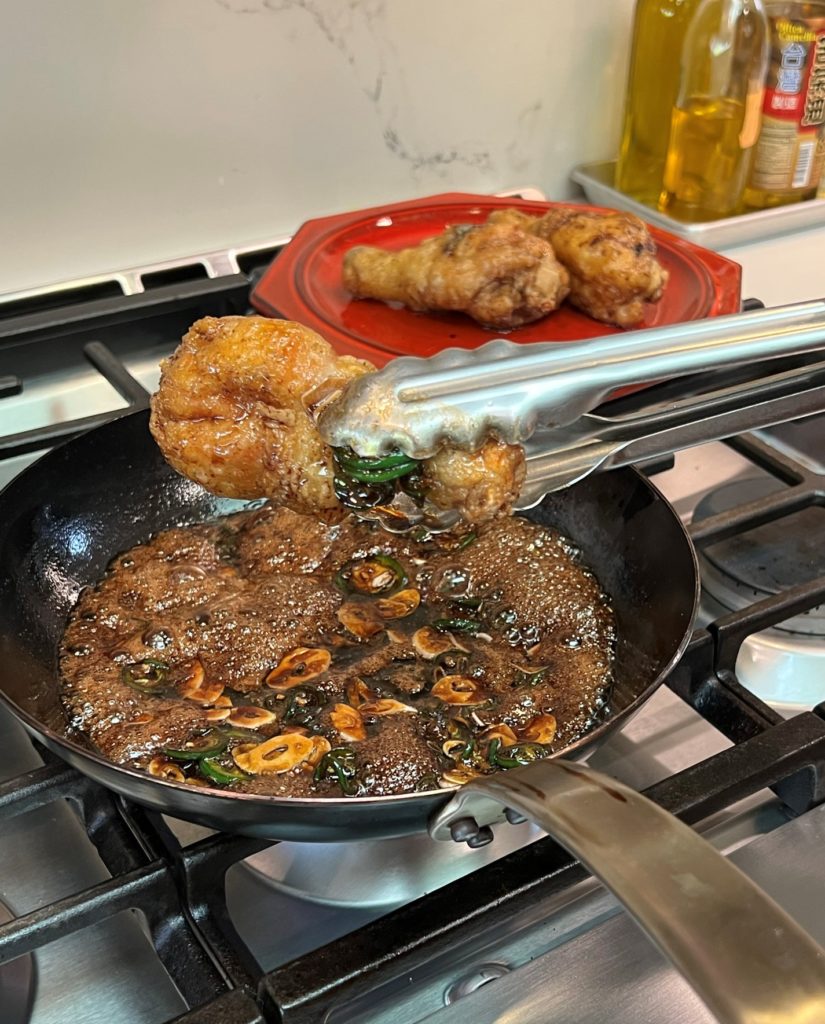
The Kim family’s fried chicken isn’t oily. There’s a lot of oil left in the skillet when you’re done glazing. But, the chicken has an exterior that’s very crunchy, sweet, salty, and spicy. I refrigerated leftovers, brought the chicken to room temperature and reheated it in the air-fryer at 350F for about 5 minutes. It was delicious.
Possible Tweaks
Aunt Georgia’s fried chicken calls for a small whole chicken to be cut up. I used small chicken drumsticks. You may use small chicken legs and thighs, if you like. I like the drumstick because there’s skin all around to facilitate extra rich crispiness. If you’re going to fry and/or eat fried chicken, go for the gold. Do it all.
To cut the chicken’s richness, Kim strongly urges you to make a pickle known as Chicken Radishes. I wholeheartedly agree. It’s simple so I’ll start with that recipe first. Scroll down for the fried chicken.
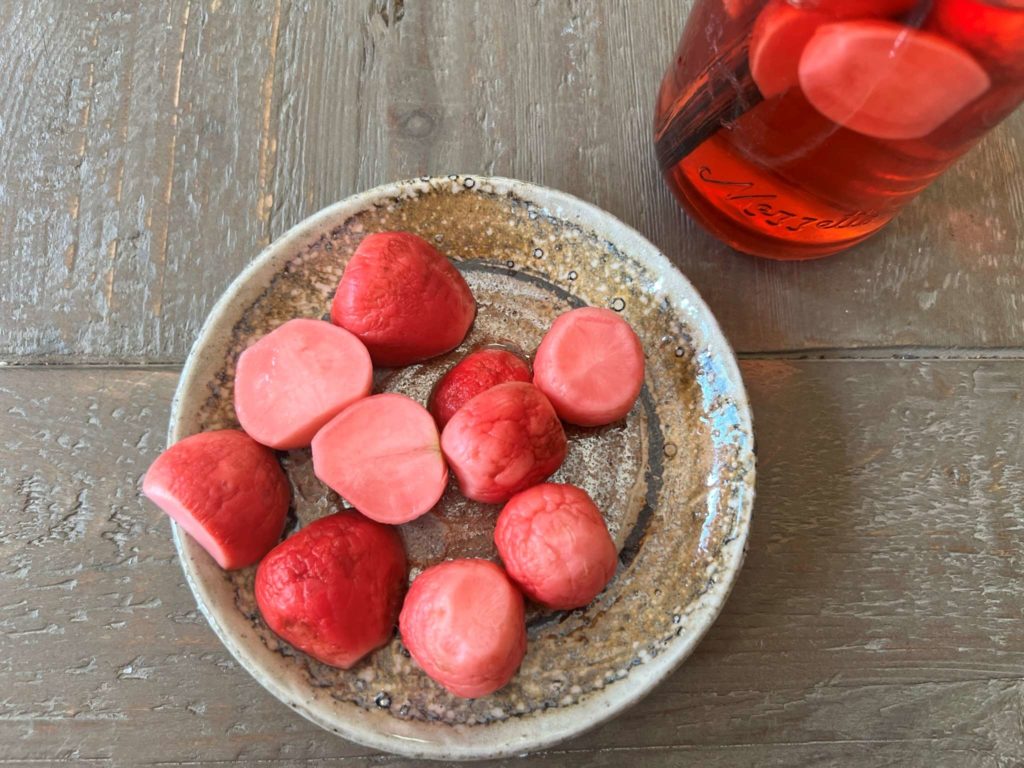
Frying chicken can get messy. I won’t lie. But, put a little effort and time in to make a great dish for your family and friends. My husband and I were so happy with our fried chicken feast that we talked about it for days. That’s what a good cookbook like Kim’s Korean American can do for you!
Chicken Radishes
Ingredients
- 10 to 12 ounces red radishes, trimmed of tops and roots, halved if large
- 1 cup water
- ½ cup distilled white vinegar
- ½ cup sugar
- 1 tablespoon Morton kosher salt, or 2 ½ teaspoons fine sea salt
Instructions
- Put the radishes in a pint-size (2-cup) jar.
- In a large spouted measuring cup, stir or whisk together the water, vinegar, sugar, and salt to dissolve the solids. Pour it into the jar to cover the radishes. Cap and refrigerate overnight or up to 1 week. Expect the radishes to get wrinkly over time.
Notes
Aunt Georgia’s Soy Sauce Fried Chicken with Jalapeños
Ingredients
- 1 3 to 3 ½ pound chicken, cut into 10 serving pieces
- Kosher salt and freshly ground black pepper
- 2 cups potato starch
- Vegetable oil, to deep-fry plus ½ cup to glaze
- 7 large garlic cloves, thinly sliced
- 3 large jalapeños, thinly sliced
- ¼ cup packed dark brown sugar
- ¼ cup soy sauce
Instructions
- In a large bowl or resealable plastic bag, add the chicken pieces and season with salt and pepper. If possible, make sure to season underneath the skin. Add 1 cup of the potato starch and toss to coat each piece. Remove the chicken pieces and repeat: Replace the pieces in the bowl or bag, sprinkle in the remaining 1 cup potato starch and toss to coat each piece again. Set aside on a plate until the starch on the chicken begins to look wet, about 15 minutes.
- Pour 2 inches of oil (enough to cover the chicken pieces while frying) into a wok or large Dutch oven. Clip on a deep-fry thermometer and heat over medium-high heat to 350°F.
- Line a plate with paper towels. Working in batches of a few pieces at a time, add the chicken to the hot oil and fry until lightly golden, about 4 minutes per batch. Transfer the fried chicken to the paper towels, let drain for only a few seconds, then refry the same pieces until golden brown, about 8 minutes per batch. Set the twice-fried, crunchy crispy chicken pieces aside on a wire rack while you repeat the double frying with all the chicken.
- In a medium skillet, combine ½ cup vegetable oil, the garlic, 2 of the sliced jalapeños, the brown sugar, and soy sauce. Set over medium-high heat and when bubbles cover most of the pan surface, use tongs to add a few pieces of the fried chicken to the sauce, quickly turning them to coat and glaze. Remove and transfer to a serving platter. Repeat with the remaining chicken. If there is glaze leftover when you’re done, return all the chicken to recoat.
- Garnish the fried chicken with the remaining jalapeño slices and serve immediately or at room temperature, when the soy sauce glaze on the outside will be at its crunchiest.














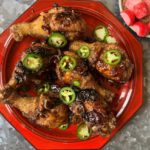




Brushjl says
Wow! Yum! This was fabulous. Yes, crunchy skin, juicy meat and a great glaze. I LOVE fried chicken and this is among the best.